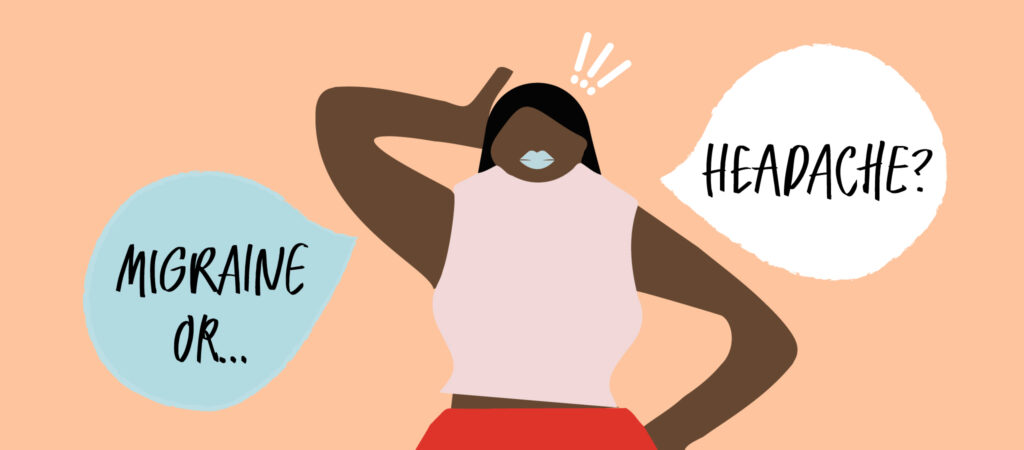How to Distinguish Between Migraines and Other Kinds of Headaches

Medically reviewed by Emily Maurer, NP on September 30, 2020
If your head’s hurting, it may seem like it doesn’t matter what kind of headache you have — you just want the pain to go away. Since contemporary headache treatments are highly specialized, knowing the exact type of headache you’re experiencing is the first step to getting better.
What is a migraine?
Migraine is a long-term condition that can cause moderate to severe headaches in those who suffer from it. The exact cause of migraine headaches isn’t clear, but each person can have a set of “triggers” that bring them on. Lack of sleep, too much caffeine and overexertion are just a few examples.
If you’re trying to figure out whether or not you’re having migraine headaches, the first thing to do is track as much about your headaches as possible. Keep a headache diary if possible, marking down the length and severity of your headaches as well as any potential triggers that may have brought them on. Sharing this information with a medical professional can help you both figure out exactly what may be causing your headaches and how to avoid them or reduce the severity.
Nurx offers prescription treatment for migraines for as little as $0 with insurance or $15 per month without insurance.
Questions you may want to ask
Just because you’re experiencing recurring head pain doesn’t necessarily mean you have a migraine. As you try and determine if you have a migraine, you might want to ask yourself some of the following questions:
Was it caused by something like stress, anxiety, or physical fatigue?
Migraines can be triggered by outside events, but tension headaches are somewhat more likely to be caused by stimulation. The most common variety of headaches, tension headaches vary highly in how people experience them — some only stick around for 30 minutes while others can last up to a week, but most are dull and affect the entire head. If your headache has been caused by external stimulation and lasts for only a short period of time, it’s probably a tension headache.
Does it recur?
Migraine is a long-term condition, meaning that those who suffer from it will experience them with some regularity for years at a time. People can experience migraines anywhere from a few times a month to a few times a year — and everywhere in between.
If your headache recurrences are more staccato, they might be indicative of a cluster headache. Cluster headaches are exactly what they sound like: highly painful events that come in “clusters,” meaning they often happen daily for several days before going away entirely for a period of time. Generally, they only affect one side of the head.
Do they come with congestion?
Stuffed sinus passages can lead to a migraine, but this kind of congestion might also indicate another kind of headache: sinus headaches. Generally arriving when you’re extremely congested, sinus headaches are the result of swelling within the head. Though they’re often confused with migraines, sinus headaches generally dissipate after whatever illness or allergies may have brought them on.
Is it the most painful headache you’ve ever had?
“Thunderclaps” are extremely painful headaches that come on suddenly and without warning. As painful as migraines can be, thunderclap headaches are often in a pain category entirely their own. They are almost always the result of a serious medical issue, and anyone who experiences a thunderclap headache should seek medical attention immediately.
Checking for migraine symptoms
While everyone’s migraines are different, experiencing some of the following symptoms may be a sign that you should talk with your doctor about possible diagnosis and treatments:
- A pounding pulsation in the head
- Pain increases with physical activity
- Nausea and vomiting
- Sensitivity to light and loud noises
- Vision changes
- Dizziness
- Fatigue
While you may experience any these symptoms, some of them may be indicative of more serious medical problems — if your headaches are severe and accompanied by any of these, get in touch with your doctor right away.
Migraine with aura
Some people who experience migraines experience them “with aura,” meaning that they have symptoms such as visual disturbances like seeing sparks or zig-zag lines in your field of vision, tingling on one side of the body, difficulties with speech or language, or difficulty controlling movement that precede or accompany their migraine.
Regardless of the cause of your headaches, you’ll want a treatment that works. Reach out to one of our medical providers here at Nurx today for your custom plan.







